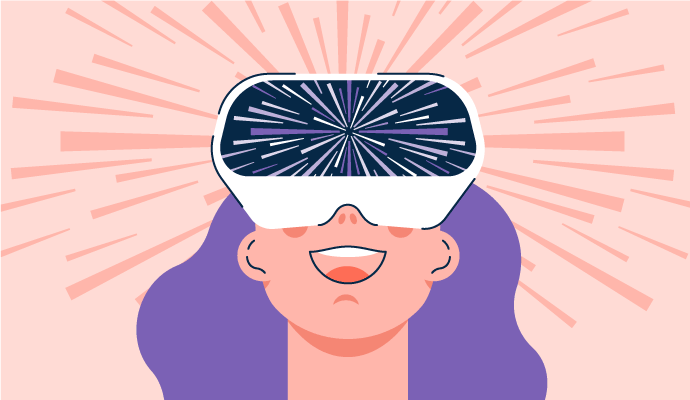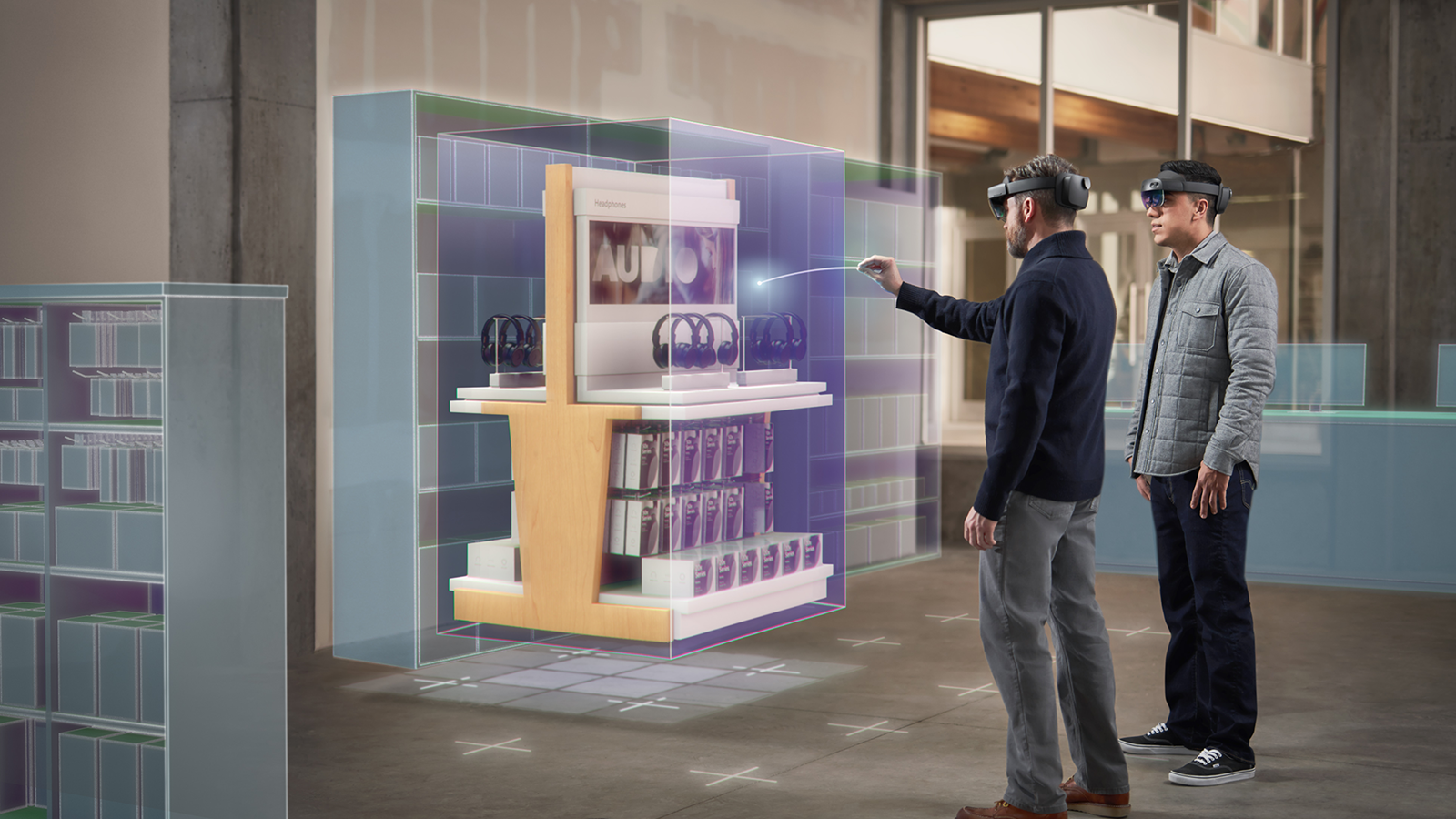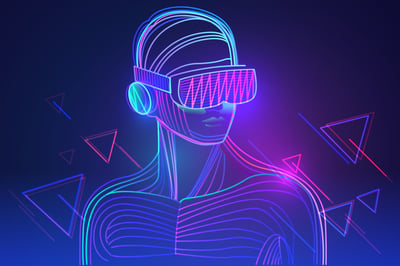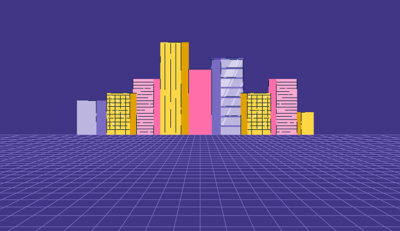February 26, 2025
.png?width=400&height=150&name=Copy%20of%20G2%20Image%20(1).png) by Shreya Mattoo / February 26, 2025
by Shreya Mattoo / February 26, 2025

One of the most evident outcomes of COVID-19 was people going completely remote as an outcome of the global lockdown.
While day-to-day and leisure outdoor activities didn't remain as prominent, people embraced new digital experiences to stay vigilant about technologies.
Be it for gaming, shopping, or virtual collaboration, immersive experiences made huge ripples and brought people together in a common virtual world to connect and communicate better.
These immersive experiences, powered by AR visualization software, eliminated remote barriers, provided real-life 3D simulations, and diversified thought patterns for better decision-making. It doesn't matter if you are indoors or outdoors; users can be teleported to any universe, receive 3D demonstrations, and remotely manage their needs better.
A truly immersive experience is an amalgamation of various technologies, such as augmented reality, virtual reality, mixed reality, computer vision, and artificial intelligence. It combines real and virtual elements of the world for wireless, 3D interaction. It also transports users to a parallel realm to view superficial content.
Humans are blessed with the power to observe and decipher their surroundings. For example, we can identify books, mountains, houses, etc., through our visual intelligence. Immersive technology takes our intelligence up a level and merges it with artificial intelligence to create virtual elements. It also represents high product promotion standards for companies aspiring to grow fast.
Let’s now see how companies put this gift of technology to work:
Currently, smartphones or specialized headsets are the most popular hardware for enjoying immersive content. On the software side, you can use a web application or a native mobile, desktop, or console app. The web application is a more universal solution, as it can run across different devices.
To create an immersive experience, technology meets major human senses of sight, touch, and smell and creates a lookalike reality for users to experience.
Devices like a VR headset, intelligent wearables, head-mounted devices (HMD), or haptic devices like gloves or controllers work well to create a sense of immersion. Examples include Oculus Rift, Microsoft Hololens, Samsung Gear VR, and HTC Vive, among many others.
Immersions are a scientific twist on how we perceive the world naturally. It adds a dash of creativity to highly agile technologies to create a user-friendly space that keeps us hooked on our current activity.
Let’s discuss different kinds of immersions that can be created:
Also known as the sense of touch, tactical immersion happens when a user literally touches an object. It measures, identifies, and transfers the message signals between the user and the surface of a real-life object through skin contact.
Tactical immersion makes you feel an artificial vibration that uniquely amplifies your experience. While it hasn't yet been widely explored in the commercial sector, it is one of the most effective forms of immersion. It can be great in the "we live in a future" kind of way, but it could also shape our present interactions.
Sight immersion is a way to integrate VR or AR to explain a product’s features. Visual experiences like these are a strong engagement point and create a sense of permanent brand recall in the customer’s mind. If you’ve ever been to a digital art museum, the charm of sight immersion might never let you leave it.
Several art exhibits across the U.S., like Area 15 in Las Vegas and the Van Gogh Museum in Washington, D.C., showcase large-scale virtual art installations and holographic arts that immerse visitors in a tech-driven creative space.
Audiences still believe in storytelling. When a content marketing strategy for XYZ products tells a compelling origin story, it increases its purchase potential. Narrative or hearable immersion lets viewers dive deeper into a product through lifelike sound and creative visuals.
Immersive theatres work with this technique. They provide an unreal but more-than-real experience by making audiences the protagonists. You can interact with the cast, deliver dialogues, and change the climax as you choose your own adventure.
This article will cover the more impactful possibilities of cooperation between business and immersive tech. But first, let's review the different benefits of immersive experiences.
Creating an immersive experience requires a proper harmony of virtual reality (VR) gear thats users mount and operate in order to experience 3D immersion. But, the VR gear alone doesn't create immersion; it is configured with AR visualization software to sense real-world data and display digital content overlays.
But fueling these AR or VR immersions also requires you to analyze various software in the market, align it with your company objectives and take demonstrations on the digital immersions you want to invest in for your audience.
To qualify for inclusion in the augmented reality (AR) visualization software category, a product must:
The following data was collected from the G2 Winter 2025 Grid Report in February 2025. Some reviews might be edited for clarity.
MirrAR provides virtual filters or simulations for consumers to try on various products for the retail sector. It offers cutting-edge 3D trials for over 12,000+ products and enables the digital application or superimposition of virtual models or digital twins into the physical environment. MirrAR is a prominent name across various brands operating in the retail, jewelry, beauty, skincare, eyewear, and makeup segments.
Companies have integrated MirrAR into their e-commerce, websites, or emails to provide the highest-quality immersive experience at the first consumer touchpoint.
"MirrAR lets you try Watches virtually. It uses AR to show how items fit you. The tech is great - you can see yours wearing things before buying. MirrAR has lots of brands and products. It's a good place to shop for fashion."
- MirrAR Review, Debbie J.
"MirrAR had some small problems. Sometimes, products would glitch or lag when trying them on, making the virtual try-on less real. Also, some products didn't quite match my face right. Their shades or styles looked a bit off. But these issues didn't happen much. The app still worked well overall."
- MirrAR Review, Ruth G.
Within is a commercial AR and VR tool that provides digital storytelling and visual-narrative features to improve customer communication and product experiences. It offers 360° content management within the application to provide an informed view of product illustrations and consumer engagement in the VR ecosystem and provides additional services to take trials or demos for informed purchase decision-making.
"It gives us the immersive experience of storytelling using the power of AR & VR. With great special audio effects, it makes past moments in front of our eyes."
- Within Review, Vimal G.
"In Within, the content library feels like it is comparatively lacking. It is not an uncommon occurrence to come across some more qualitative experience, at the same time I always seek for the new."
- Within Review, Johann H.
Overly is an ideal AR and VR creation tool that provides stringent policies and guidelines for the ethical and creative usage of 3D technologies and ethical consumer interactions. Overly provides an integrated development interface to develop your virtual reality interface, configure virtual navigation, or develop content libraries to make your application more effective and agile while keeping in check the memory limit of your VR hardware.
"I have to add that Overly Creator is very simple and easy to use. It is quite entertaining to create simple AR applications just by utilizing a feature. This means AR innovation is now open to a group of people who do not ordinarily participate in AR development."
- Overly Review, Nadianauli Y.
"I realized that the number of templates available was not very large, and this limited creativity. It is simple and unimpressive, and certain aspects appear to be cumbersome or as if they are not integrated properly."
- Overly Review, Dinh D.
Aryel is a software development kit (SDK) for building AR or VR interfaces for web marketing operations or product generation lifecycles. It also offers built-in object detection to scrutinize facial expressions, consumer sentiments, and hand gestures in the metaverse and make proper commercial nudges to convert customers.
"They really care about their product. They saw that I was asking a lot of questions in their chat, and they invited me to a call. On the call was the manager but also a technical person. We discussed what I wanted to achieve, and they helped me find a solution that would be good for me. Additionally, they even gave me some examples of other things I could do (that were not even released yet), and that sparked new ideas for me. This shows they really care about their customers having success."
- Aryel Review, Anina N.
"Aryel loading times could be faster, though it might also be due to my bandwidth. I wish they could allow the loading of large AR models with separate layers or components
- Aryel Review, Suryakant N.
Xarwin provides digital immersive content experiences via various marketing channels like websites, e-mails, or social media to give consumers a supreme metaverse experience. It is stocked with various content templates, conversational prototypes, avatars, and experiential simulations to bring lifelike experiences to the consumers' table.
"Xarwin is a wonderful platform for building immersive WebAR experiences. Consequently, even those without coding skills can produce immersive WebAR experiences."
- Xarwin Review, Deergasi V.
"The results may not be satisfying every time. If you are not using a paid version of the service, the result may not be the same as you wanted. This is something expected, but it may be project-based payments."
- Xarwin Review, Arda A.
Creating intelligent interactive experiences works wonders for growing your business’ consumer base. Investing in technology fads like glossy e-brochures or over-the-top data irrigation can make you run into losses. Immersive experiences help gain 360° coverage of your product and promote it in a way people explore all its features visually.
It is a game-changing trend that every company will hop on to in the future.
While working with immersive technology, it’s crucial to be vocal as a human touchpoint and monitor the backend systems responsible for the smooth functioning of product exhibitions. Here are some benefits of immersive experiences that technologically transform a business:
of customers say that they feel an emotional connection to the brands they buy from the most.
Source: Salesforce
Flashing highly modern tech gadgets isn't the only way of creating an "out-of-the-box" experience for consumers. You may have an illustrious team of engineers and marketers at work for your product, but still, end up countering your consumer practices.
Creating an immersive experience should take your customers to a higher state of mind, where they can be 100% percent sure of your product value. It’s about creating an impeccable "start-to-finish" journey of your brand that cannot be interrupted at any stage of action.
Keep on reading about the latest technological innovations to rein in your business competition and leave your customers feeling happy, energized, and satisfied:
360° content helps us integrate two or more videos in a dome-like space shot from all possible angles, with 2D instructional content overlaid on top of them. Marketers and advertisers can use it to walk customers through a detailed range of product features and benefits. Rather than focusing on creating a different reality, users can create a wide-eyed version of the product in the real world.
In the travel and tourism industry, 360° content lays the groundwork for travelers to pre-visit a particular destination. From showing skylines to providing a birds-eye view
of a city, it creates a completely "submerged" experience. All of this is enough for wanderlust to hit the road without a second thought!
A digital twin is a "carbon-copy" representation of a real-life component, structure, or process. A digital twin machine is updated using real-time tracking data and fuelled by 3D-modeling techniques to interact actively with our environment.
It’s a digital alternative to a real-life asset built with robust machine learning and automation techniques. Digital twins are ideal for quality assurance tasks and provide quick insights into a product anytime, anywhere, for faster decision-making.
A great example is satellites. Digital twins of satellites help foresee potential dangers, fuel shortages, engine and steering power, and other parameters of any spacecraft mission.
Building a digital twin helps:
Source: Geospatial World
Virtual reality is a complete turnaround of reality. It immerses a user in a virtual environment with overlays of controls like GPU, responsiveness, sound, or motion smoothing, allowing them to interact through their digital avatars.
Imagine sending your digital avatar to attend a meeting in place of yourself. Your avatar participates in the conference in your company's developed metaverse, jots down the minutes, and reports back to you once the session is over.
At McLaren, car designers use VR software to design schematic car models. VR creates a live hologram of the car, which designers can alter to make design changes. Volvo engineers also use VR software to simulate drive trials and customize designs accordingly.
Source: TedxTalks
Augmented reality means enhancing users' real-world perception through virtual overlays. It extracts hidden features of real-world objects through object recognition and showcases informative content about them. Although in its infancy, AR has the potential to upend the way people communicate.
With the help of a camera, an AR device, and a smartphone, you can recreate a different reality for your customers to enter, play around with, and shop in. Adding AR to the customer spectrum adds a whole new dimension to the shopping experience, which single-handedly lifts the purchasability of a particular product.
AR has also marked a successful milestone in medicine. Radiology departments incorporate AR technology during pathological tests to study medical procedures and evaluations. By virtually mapping a patient's X-ray data, radiologists can identify abnormalities in bones and classify the disease more quickly than before.
Mixed reality tries to combine AR and VR into an enhanced version of AR. It adds digital overlays of information and develops virtual characters for the real world. Its goal is to create a deeper sense of immersion for the user than AR alone does.
Sometimes, mixed reality is also known as augmented reality 2.0, as the counterparts of the virtual world interact with real-world objects in real-time, thus creating a parallax effect. People can live, work, trek, shop, and survive more realistically in an MR world than in VR, as it keeps them connected to their roots. Mixed reality is also known as hybrid reality.
Did you know? tagSpace, an Australian tech company, has launched a new MR platform for users to create, share, and monetize their experiences using blockchain technology, all with powerful drag and drop – no coding experience required. It will also include virtual digital billboards for creators and brands.
 Source: Microsoft
Source: Microsoft
Extended reality (XR) is an umbrella term for every immersive technology that exists. It includes augmented reality, virtual reality, mixed reality, digital twins, and other immersive learning technologies. This technology is a natural extension of reality by adding digital counterparts in the form of inscriptions, videos, or animations.
Extended reality is apt for use in employee training programs as it eliminates the hassle of extra training staff and the costs of training employees.
Its activation makes you walk through a live hologram of a product and understand its features. Accenture uses full-scale XR to create highly personalized experiences for its clients through sight, touch, and sound.
Tip: You can create a VR experience in two ways for employee training purposes
People learn through experiences. Uplifting customer experience with immersion is a ticket to success for businesses looking to expand in the online market.
Immersive experiences amplify brand visibility by highlighting product features for consumers in their own personal spaces.
If you plan to open a makeup business, your prime focus should be twofold: creating a fantastic product and choosing the right way to pitch its benefits to retailers. Image recognition software identifies and labels feature data and elevates your product's overall look and feel.
This helps you stand out as a product owner and cements the vendor's trust in your business pitch to strike a successful deal.
Immersive experiences have several applications in the commercial sector, ranging from defense to healthcare to gaming to architecture and construction.
Typically, companies use webhook automation or ERP systems to manage and retrieve data from databases. These processes can get a bit complex and technical. An AR headset can help make data visualization easier to understand. With its help, a user sees only the most critical bits of data. The headset shows all the details when the user looks at specific parts of the data report.
Here are some of the many use cases of immersive experiences that have entered the spotlight:
In the e-commerce sector, companies manufacture their products with built-in QR codes. With the help of a QR code generator, they generate QR codes that are GDPR compliant and provide tracking data. When a user scans the code, virtual popups explain all the necessary steps to successfully install and use the products in a home setting, all from the shopping floor.
In addition, using a VR headset brings users into a place where everything works in compliance with this product. Customers can explore every part and compare its features with other products in real time on social media.
With retail image recognition software, retailers and brands use AR technology to seamlessly connect their customers to an intuitive, visual, and modern shopping experience.
In the military, VR technology can create actual reconnaissance scenarios and test the power of the army to face them. Through a VR headset, soldiers can find themselves on a virtual battlefield with a virtual opposition charging at them!
The headsets' sensors enable precise measurement of reaction times and other important safety factors. VR also ensures a physically safe environment for army regiments to practice combat or surgical strike operations.
Mining operations
Immersive experiences in mining allow an entire team of mining operators, workers, and managers to make the process safe and efficient. Through VR, workers can practice their mining skills in virtual scenarios or create replicas of mine sites without risking their lives.
It also gives them a better understanding of what is expected and how to manage disastrous situations. You might say that immersive technology is a gold mine in itself!
Immersive technology was coined in the aviation sector. It allows flight engineers and ground handlers to identify, probe, and analyze situational outcomes before an aircraft takes off. It helps the crew run their aircraft maintenance and engineering checks from a remote location.
With VR simulation, the aircraft crew can work in high-fidelity environments and practice extreme situations of the aircraft like birdstrike, flameout, stalling, nose dives, etc. AR/VR headsets also put teams on the airside and allow them to interact with aircraft holograms to conduct visual inspections or cargo inspections.
VR grants us the ability to explore building designs on a 1:1 scale. Things get even better when we add mixed and augmented reality. These technologies surround designers with 3D prototypes, allowing them to brainstorm design edits virtually.
Designers use mixed reality to create 3D renders of products and test them in real life. Getting a bird' s-eye view of the product before its development smooths the design process.
Sometimes, designers combine traditional 2D CAD applications with VR tools to perfect their designs. Examples include software like V-Ray or SketchUp.
Source: archdaily
Immersive tourism, also known as experiential tourism, takes a traveler on a virtual journey to experience scenic attractions, a new culture, and a new set of feelings.
360-degree content and virtual reality provide customers with the option to try before they go somewhere. It allows them to check out the destinations they want to visit to make sure that's the right choice. Later, they can “walk around” the hotel room they intend to book to see if it's to their taste.
An augmented reality HMD headset can serve as a personal tour guide, available to you at all times. It can provide additional information in real time, making sightseeing easier and more informative. It'll also help with finding cafes, restaurants, hotels, inns, and landmarks that have the highest user reviews
VR is known to reduce the costs associated with logistics and trucking by providing virtual navigation routes for the pickup of goods! This increases worker efficiency and expedites the logistics process.
MR devices can support supply chain professionals by superimposing routes over truck windshields. AR devices can also streamline production cycles by speeding up setup time between machines and notifying teams when supplies perish.
Source: Strategic systems
Immersive experience has various use cases in the entertainment sector.
During the initial lockdown for COVID-19, many in-person events were conducted virtually using immersive technology that compensated for the lack of physical presence.
Immersive technology brings old historical anecdotes to life through virtual installations. Just like 3D projectors, immersive devices can help you experience a concert or movie as if you are in it through “digital factories” or “experience studios”.
These games are created using a video engine, 3D graphics, head-mounted devices (HMD), and motion controllers like PlayStation DualShock to control virtual characters' movement.
Grand Theft Auto: Vice City or Fallout are key examples of such immersive games that create highly engaging user experiences.
You can download and play these VR games through Google Cardboard.
Here are a few examples of AR immersive games that have been adopted successfully across the world:
Did you know? HTC Vive is the world's first AI-driven personalized spatial audio software for all headsets and PC games. It can turn any headset into a full-fledged sound system in minutes!
Immersive technology allows real estate agents to create unique experiences during virtual showings. Potential buyers check out properties remotely, at a time that's convenient for them, without the help of a real estate agent. During in-person showings, a mixed reality headset can help by providing additional information about the property, decoration options, or furnishing suggestions.
Besides technological shortcomings, primary health and safety factors associated with immersive experiences discourage their use in the broader community. Here are some other challenges posed by immersive technologies that roadblock its success streak:
We live in a golden age where technologies like artificial intelligence, virtual reality, and green computing have made everyone a content creator.
Immersive experiences will be a futuristic tool to provide a level playing field for businesses to emerge as market leaders. Combining emotion with cutting-edge technology can best serve customers and set industry benchmarks for them to scale unimaginable milestones!
Explore the best VR content management system today to store your web resources in a centralized place and create quality 3D content!
This article was originally published in 2022. The content has been updated with new information.
Shreya Mattoo is a former Content Marketing Specialist at G2. She completed her Bachelor's in Computer Applications and is now pursuing Master's in Strategy and Leadership from Deakin University. She also holds an Advance Diploma in Business Analytics from NSDC. Her expertise lies in developing content around Augmented Reality, Virtual Reality, Artificial intelligence, Machine Learning, Peer Review Code, and Development Software. She wants to spread awareness for self-assist technologies in the tech community. When not working, she is either jamming out to rock music, reading crime fiction, or channeling her inner chef in the kitchen.
Mixed reality apps (MR) are taking the internet by storm.
 by Jose Bort
by Jose Bort
Metaverse means "beyond the universe” and was introduced to us by authors like Neal Stephenson...
 by Sagar Joshi
by Sagar Joshi
From time to time, every business goes through ups and downs.
 by Slava Podmurnyi
by Slava Podmurnyi
Mixed reality apps (MR) are taking the internet by storm.
 by Jose Bort
by Jose Bort
Metaverse means "beyond the universe” and was introduced to us by authors like Neal Stephenson...
 by Sagar Joshi
by Sagar Joshi


